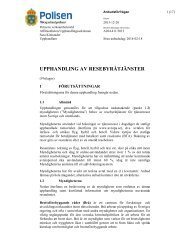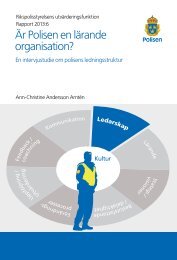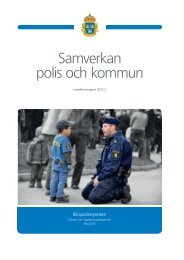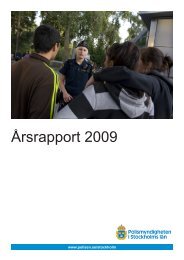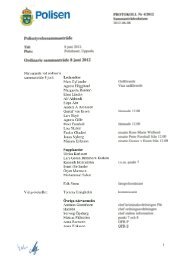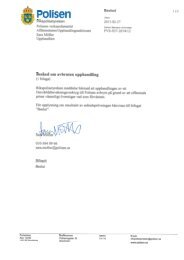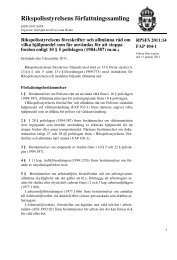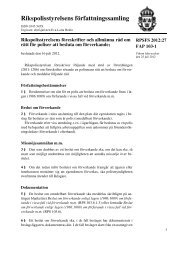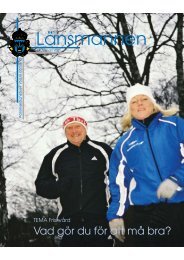Trafficking in human beings for sexual and other purposes - Polisen
Trafficking in human beings for sexual and other purposes - Polisen
Trafficking in human beings for sexual and other purposes - Polisen
- No tags were found...
Create successful ePaper yourself
Turn your PDF publications into a flip-book with our unique Google optimized e-Paper software.
3. Crim<strong>in</strong>al Development22that “situations that entail distress as <strong>in</strong>dicated by thepenalty clause concern<strong>in</strong>g <strong>human</strong> traffick<strong>in</strong>g arewhen a person is <strong>in</strong>duced to work under particularlydifficult conditions at a very low wage. An<strong>other</strong>example is when a person is <strong>in</strong>duced to beg or steal. 27 ”In 2011 one person was convicted <strong>for</strong> <strong>human</strong> traffick<strong>in</strong>g<strong>for</strong> <strong>purposes</strong> <strong>other</strong> than <strong>sexual</strong>. That case concerneda man from Bulgaria who transported a12-year-old Bulgarian girl to Sweden to commit thefts<strong>in</strong> Sweden <strong>and</strong> <strong>in</strong> <strong>other</strong> countries <strong>in</strong> Europe. In somecases of <strong>other</strong> types of <strong>human</strong> traffick<strong>in</strong>g, the proceed<strong>in</strong>gsare dismissed because of a lack of evidenceshow<strong>in</strong>g that the suspects, as early as at the time ofrecruitment, <strong>in</strong>tended to mislead the victims or thatno exploitation could be proven. (See Annex 3).The police authorities’ reports to the SwedishNational Police Board dur<strong>in</strong>g the year <strong>in</strong>dicate thatthe number of reports, prelim<strong>in</strong>ary <strong>in</strong>vestigations <strong>in</strong>itiated<strong>and</strong> cases brought concern<strong>in</strong>g <strong>other</strong> <strong>human</strong>traffick<strong>in</strong>g <strong>in</strong>creased more than those concern<strong>in</strong>g<strong>human</strong> traffick<strong>in</strong>g <strong>for</strong> <strong>sexual</strong> <strong>purposes</strong>.In 2011 the police drew up 35 reports on <strong>human</strong>traffick<strong>in</strong>g <strong>for</strong> <strong>sexual</strong> <strong>purposes</strong> <strong>and</strong> 63 reports concern<strong>in</strong>g<strong>human</strong> traffick<strong>in</strong>g <strong>for</strong> <strong>purposes</strong> <strong>other</strong> than<strong>sexual</strong>. These <strong>purposes</strong> generally concerned situations<strong>in</strong> which people had been brought to Sweden bycrim<strong>in</strong>al gangs from <strong>other</strong> countries to be exploited<strong>for</strong> begg<strong>in</strong>g, <strong>for</strong> <strong>for</strong>ced labour or <strong>for</strong> complicity <strong>in</strong>crim<strong>in</strong>al activities such as organised theft. In 2010 thepolice drew up 32 reports on <strong>human</strong> traffick<strong>in</strong>g <strong>for</strong><strong>sexual</strong> <strong>purposes</strong> <strong>and</strong> 52 reports concern<strong>in</strong>g <strong>human</strong>traffick<strong>in</strong>g <strong>for</strong> <strong>purposes</strong> <strong>other</strong> than <strong>sexual</strong>.3.2.1 Forced labour or situations that <strong>in</strong>volve distressWith<strong>in</strong> several sectors <strong>in</strong> the Swedish labour market,<strong>for</strong>eign labour is be<strong>in</strong>g used to an <strong>in</strong>creas<strong>in</strong>g extent.Workers from countries outside the EU require awork permit <strong>and</strong> these people are often recruited with27 Gothenburg District Court Dept. 4, 30.01.2012, Case no.15416-11, p.23.the help of <strong>for</strong>eign manpower agencies. For workersfrom <strong>other</strong> EU countries, no such permit is required.Concurrent with <strong>in</strong>creases <strong>in</strong> the <strong>for</strong>eign work<strong>for</strong>ceon the Swedish labour market there has also been an<strong>in</strong>crease <strong>in</strong> the <strong>in</strong><strong>for</strong>mation provided to the policeconcern<strong>in</strong>g factors such as poor work<strong>in</strong>g conditions,unreasonable terms of employment <strong>and</strong> wages, difficulties<strong>in</strong> gett<strong>in</strong>g paid <strong>for</strong> work done, but also concern<strong>in</strong>g<strong>human</strong> traffick<strong>in</strong>g <strong>for</strong> <strong>for</strong>ced labour.The concept of work<strong>for</strong>ce exploitation is understoodto mean a situation that may <strong>in</strong>volve hardlabour, long hours <strong>and</strong> low wages. Under Article 2 ofILO Convention No. 29, <strong>for</strong>ced labour is def<strong>in</strong>ed as 28 :a) any work or serviceb) that is dem<strong>and</strong>ed from a person under threat ofsome k<strong>in</strong>d of punishmentc) <strong>and</strong> to the per<strong>for</strong>mance of which the person concernedhas not will<strong>in</strong>gly agreed.Human traffick<strong>in</strong>g <strong>for</strong> the <strong>purposes</strong> of <strong>for</strong>ced labourcan be difficult to prove because the people be<strong>in</strong>gexploited do not always see themselves as victims –even <strong>in</strong> cases where the police <strong>and</strong> prosecutors suspectthese crimes have taken place. The victims areparticularly vulnerable when they are <strong>in</strong> a <strong>for</strong>eigncountry with a <strong>for</strong>eign culture <strong>and</strong> if they do not havea comm<strong>and</strong> of the language. However, it can be difficultto determ<strong>in</strong>e the extent to which a person mayhave been exploited <strong>and</strong> whether the exploitation isserious enough to be considered crim<strong>in</strong>al under thetraffick<strong>in</strong>g legislation. In addition, victims are usuallyable to move about freely but are deprived of theirliberty <strong>in</strong> more subtle ways, <strong>for</strong> example by threats ofreprisals or by be<strong>in</strong>g deprived of their passports orbe<strong>in</strong>g <strong>in</strong>debted to the perpetrators. This makes it difficultto prove the power relationship that should existbetween the perpetrator <strong>and</strong> the victim.In 2011 the police received <strong>in</strong><strong>for</strong>mation that <strong>for</strong>eignemployees who had been promised work with<strong>in</strong> the con-28 International Labour Organisation.




